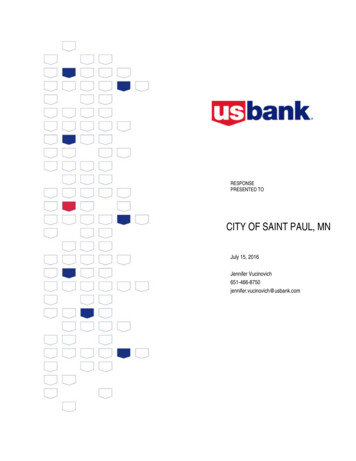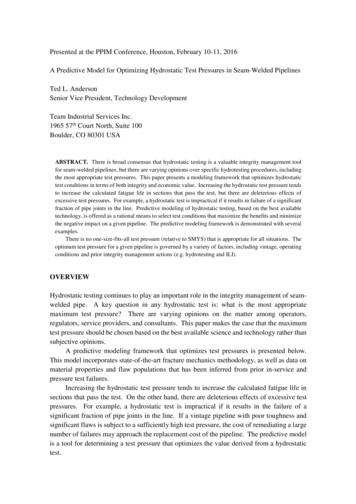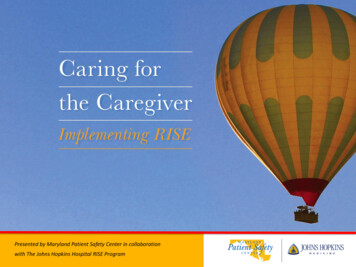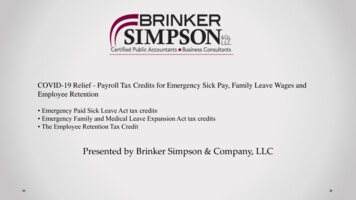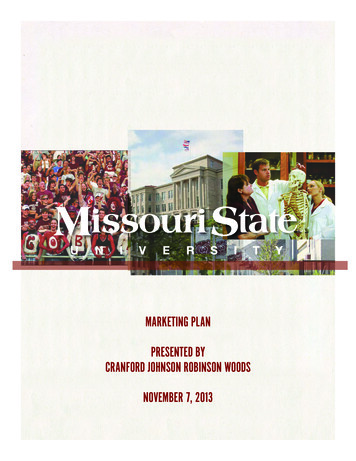
Transcription
MARKETING PLANPRESENTED BYCRANFORD JOHNSON ROBINSON WOODSNOVEMBER 7, 20131
TABLE OF CONTENTSGOALSTARGET AUDIENCES4SWOT ANALYSIS6MARKETING STRATEGIES8PAID MEDIA16HIGHER-PRICED MARKETS19RECRUITMENT EVENTS21PUBLICATIONS23MEASURING OUTCOMES2552
INTRODUCTIONCranford Johnson Robinson Woods (CJRW), and Penn, Schoen & Berland (PSB) have been MissouriState University’s marketing partners since 2012. The partnership started with a thorough researchstudy implemented by PSB, which gathered insight from a variety of constituencies such as keyadministrators, faculty, staff, alumni, graduate students, undergraduate students, prospectivenon-traditional students, prospective transfer students, admitted students who did not enroll, allprospective high school students, and parents of prospective students.The in-depth findings of the research study can be found in the “Phase II Quantitative Report,” butthere are five key findings used as the framework for this marketing plan. MSU received positive ratings across all audiences. Key strengths include location, campusofferings, facilities, and value. Traditions and school spirit are areas to improve. Additionally, MSU has room to improve itsnational recognition and brand identity. Tagline and mission statement are effective, but awareness is low. After being aided, thetagline and mission boosted interest among prospective audiences. Website is viewed positively, but can be further utilized. Many would like to see additionalinformation on upcoming university events; alumni would like to use website to strengthenalumni network. Messages resonate strongly and move the needle on key metrics. The messages boostfavorability and strength of reputation considerably across key audiences. Results validatemessages as a strong basis for future MSU communications efforts.Research findings and this marketing plan will help MSU recruit a higher number of students, andmore academically qualified students. During the Fall 2013 semester, MSU announced a recordbreaking enrollment. The institution reported an enrollment of 23,838 students, which is the highestsince 2010. While this represents an outstanding success for the university, research findings andthis marketing plan will help the university move forward with progressive tactics. The highereducation recruiting landscape is becoming more aggressive, as universities compete for a smallernumber of students due to the declining size of high school graduating classes. Universities are alsocrossing state borders with attractive in-state tuition offers in order to attract out-of-state studentsto supplement in-state shortages.While recruitment will be an important component of this marketing plan, a cohesive brandingstrategy will be necessary to elevate and propagate the university’s current tagline: “FollowYour Passion. Find Your Place.” By redefining the meaning of this tagline, MSU will be able tosuccessfully recruit students, motivate faculty and staff to embrace the tagline, and reconnect andreengage with alumni and donors.3
GOALSAll strategies proposed will help MSU achieve three main goals. These statements define howMissouri State University will use marketing to further advance the university’s brand, image,recruitment efforts, and internal and external engagement opportunities. Redefine meaning of tagline in a way that elevates academic excellence along with key assetsdefined in research study Develop a strategy that will promote campus-wide propagation of “Follow Your Passion. FindYour Place” tagline Develop a strategy to garner interdepartmental support for the tagline and achieve cohesivevisual and written executions4
TARGET AUDIENCESTHE FOLLOWING ARE THE TARGET AUDIENCES FOR THE MARKETING PLAN:RECRUITMENT Junior and senior high schools students Parents of prospective high school students Prospective graduate students Prospective transfer students Adult studentsBRANDING Prospective students (all) Parents Current students Faculty (current and prospective) Staff (current and prospective) Alumni General public5
SWOT ANALYSISThe following SWOT analysis is based on research findings, but it also includes feedback provided byfaculty and staff members during a two-day discovery session held at MSU.STRENGTHS Location Campus offerings and facilities Affordability and valueWEAKNESSES Brand and national identity School spirit and traditions AthleticsOPPORTUNITIES Variety of programs with regional and national reputation in all colleges Key programs that can provide credible claims to innovation Majority of classes taught by faculty, not teaching assistants Long tradition as an institution that prepares educators Personal atmosphere, but large enough to offer a wide variety of opportunities Student-to-professor ratio Advisement centers Internship program STEM Institute A relatively high percentage of research conducted by undergraduate students in selectcolleges Build-your-own-major opportunities Unique study away program Living and learning communities Proximity to respective feeder markets Dedicated corporate relationship specialists Existing large recruitment event format Unique out-of-the-classroom opportunities in key programs (field school, emergencymanagement class, study abroad) Programs available completely online 90 percent of faculty members have a Ph.D. 78 percent of students receive some type of financial aid Availability of academic assistance for nontraditional students A wide variety of accredited academic programs in most colleges6
SWOT ANALYSISTHREATS Lack of pride and participation in athletic events Lack of Ph.D. programs Lack of research opportunities in a few programs with research needs Campus diversity Students in certain programs do not take advantage of internship opportunities Lack of cohesiveness and uniformity in decentralized communication strategy Multiple alternative taglines for colleges and specific programs A saturated market for graduate programs within MSU’s area7
MARKETING STRATEGIESBRANDINGOver the past several years, Missouri State University has gone through significant brandingchanges. The most recent one was the adoption of the “Follow Your Passion. Find Your Place.”tagline. Findings from the research study reveal the tagline has low awareness. However, surveyrespondents, including students who were admitted but not enrolled, had positive reactions tothe tagline once aided. This feedback confirms the current tagline has the potential to succeed oncampus and off campus.Like many large higher education institutions, MSU has a decentralized communication system.This structure can be challenging for any communication outreach, but even more challenging whentrying to successfully implement a rebranding strategy.Many times, implementation challenges stem from lack of ownership in the brand, lack ofopportunities to achieve individuality, lack of options flexible enough on design skills, and lack ofresources. In order to overcome these challenges, MSU should consider implementing the followingstrategies: Rejuvenate the Look of the Brand: Consider forming an advisory committee to develop a newlook for the overall brand, including the tagline. The committee would include representativesfrom the student body, staff, and faculty from the different colleges. Working as a team wouldhelp different constituencies obtain a sense of ownership and pride over the rejuvenated brand. Ifcurrent staff members have the skills and experience in this type of rebranding effort, MSU couldselect a team of professionals that can work cohesively. This team should also have the capacityto provide a wide variety of options. New concepts would be presented to the committee for apreliminary evaluation. This exercise should include mock-ups that showcase how each optioncould be implemented through different executions. If the university doesn’t have the resourcesto handle this task internally, a consulting marketing firm should be approached to handlethis project. The design firm would work together with the advisory committee. The process tosuccessfully rejuvenate the brand should include: Gathering an advisory committee that represents different constituencies andacademic departments. Recruiting design professionals from the campus community or consideringoutsourcing design initiative to a marketing partner. Developing a five-to-seven-question survey for representatives from eachconstituency to use to gather feedback from their respective groups. Questions wouldhelp assess what defines the brand within the community. Develop a creative brief that merges research findings and preliminary qualitativeresearch from internal groups. Create a word farm with the results from the surveys. This tool could be used togenerate inspiration for graphics and visual interpretations.8
MARKETING STRATEGIES Develop layout options that would be reviewed and revised by the committee. Layoutoptions should highlight the versatility of each option and how it can be executed fordifferent departments while achieving consistency and individuality. Let Qualitative Research Guide the Final Decision: The committee should narrow the new brandingoptions to two or three. These options should then go through a series of focus group testingto benchmark opinions from different target audience groups. Results from the focus groupswould help MSU choose a new look for the brand. More importantly, findings from the groupswill provide insight that will improve the final product. The focus groups should represent thedifferent constituencies, but the different audiences should be kept separate during the testingprocess. Making a decision based on research will strengthen the credibility of the brand and thefinal choice would be the community’s choice.MESSAGINGStrong brand standards define more than just the look of the brand. They also define the meaningand core of the brand. The campus community needs to understand the origin and core of the brand,and how it will take the university forward. Share the Origin of the Brand: During the discovery meetings, a few members of the faculty and Redefine “Follow Your Passion. Find Your Place.”: The branding study reports clearly states thestaff knew the story behind the origin of “Follow Your Passion. Find Your Place.” tagline.However, the majority was unaware of this part of the university’s history. As the researchfindings stated, current perception is that the university lacks traditions or awareness ofexisting traditions. Providing this background will add another layer of meaning to the tagline.Combining the tradition behind the brand, the community effort to develop a new visualexecution, and the qualitative research findings will increase the adoption rate of the brand.Success rates will improve by creating a brand essence that’s the result of an inclusive process,with research findings to support it.top attributes associated with MSU’s brand: location, affordability, value, campus offerings,and facilities. All of these are assets that resonate with the target audience and should bepart of the university’s key messaging strategy. However, these tend to be the same attributesassociated with community colleges. This is why MSU should avoid defining its brand basedsolely on the target audience’s perspective. The university should incorporate messaging thatincludes the institution’s competitive advantages. The core of MSU’s communication effortsshould be tied to unique academic opportunities. Currently, many of the messaging points focuson general facts about the university. Most of these executions are too broad. Uniqueness could9
MARKETING STRATEGIESbe defined by having programs not offered anywhere else in the region, highly ranked programs,and job placement rates, among others. The core strategy should highlight how MSU can helpstudents follow their academic and professional passion, while being part of a community thathelps them find their place as they enjoy a complete college experience. All messaging shouldlead with academic programs and follow with value and campus offerings talking points. Animportant element needed to successfully implement this communication strategy is a bettertracking system in all colleges. More than likely there are key programs within each college thatprovide outstanding job placement rates or acceptance rates into prestigious graduate programs.These measurable success stories will provide credibility and positioning opportunities to thecommunication strategy. Build the Brand Through the Success of Academic Programs: One of the most damaging weaknessesfrom the research study is the misperception that MSU’s graduates are limited to local or instate opportunities. The foundation of the university’s tagline should be the academic excellenceachieved through each college. MSU’s brand should be built around the far-reaching opportunitiesenjoyed by students and alumni. Currently, MSU utilizes the “Spotlights” program to highlightsuccess stories from alumni, students, and faculty. These profiles are used in print, online, andin other outlets. Spotlights successfully communicate far-reaching opportunities after obtaininga degree from MSU. However, the execution of each highlight should include visual elementssuch as photography and short videos. The current text-heavy format might not be attractive forsomeone casually seeking more information about MSU. The key is to provide the information ina format that will turn a casual reader into an engaged reader.Making “Spotlights” shorter and with more graphics is extremely important for the currentstudent profiles. While the general public will relate to alumni success stories, it is sometimeschallenging for high schools students to see themselves five to 10 years in the future. Alumnihighlights that are more successful with high school students tend to showcase new graduateswho have accomplished notable successes within a year or two after graduation. Ideally,recruitment efforts should focus on current student “Spotlights.” In order to maximize theeffectiveness of the profiles, students should experience the story in a multimedia format that isshort and delivered in a current format. This messaging strategy should be directly correlated tounique programs with successful placement rates. At the same time, messaging should illustratehow students at MSU have access to affordable excellence, while enjoying the complete collegeexperience. This can be achieved by highlighting programs where current students and newgraduates have benefited from MSU’s leadership in a given field. These students should alsodemonstrate a well-rounded experience that goes beyond the classroom’s walls.MSU should also consider this approach on mass media executions. Recruitment campaignsshould highlight current student success stories in the format described above. Studentshighlighted should have experience that can be shared in 30-second radio spots, print ads, and10
MARKETING STRATEGIESonline ads. To extend the messaging, MSU could develop a website to expand each story. Whilethe website would certainly serve as a recruitment tool, it would also be an ideal portal toreintroduce the general public to the academics-driven “Follow Your Passion. Find Your Place”brand. The website would provide links toward any relevant content within the main site.The website would be an extension of mass communication efforts, and its main goal would beproviding positioning opportunities for the university. The site would act as a portal where casualreaders can be become engaged readers who would eventually be routed to missouristate.edu tolearn more. Taglines: Upon reviewing existing publications, it’s clear there are many alternate taglines.Many colleges have their own taglines, and programs within those colleges have taglines aswell. Colleges spend a considerable amount of effort building awareness of these taglines. Theabundant number of marketing statements exacerbates the lack of awareness of “Follow YourPassion. Find Your Place.” Many times, a college concentrates its efforts in building awareness ofits tagline and leaves the institutional tagline out to avoid confusion. These issues will preventthe university’s tagline from achieving its full potential. The communication strategy for this planrelies heavily on the outstanding programs available in each college. The strategy behind thisplan will help colleges achieve notoriety through institutional marketing. The alternate taglinescan still be part of promotional materials, but their roles should be minimized to “welcomeheadlines” or “sign off statements.” These taglines should not be as prominent as the oneattributed to the university. By following the recommendations in this plan, colleges will play aprominent role in the rejuvenation of the brand. Colleges would also receive prominent exposurein mass media efforts. In return, the university should experience increased participation fromdifferent colleges and programs in the implementation of an integrated communication strategy.PROPAGATIONOnce new visual and messaging strategies are finalized, the overall marketing strategy and tacticsshould be shared with the campus community. Roll out the Final Product: Since different constituencies will be included in the developmentprocess, it is important for them to see the final product. MSU should consider holding a campuswide assembly where the refreshed brand and its different executions are introduced. Thepresentation could be delivered through a video, where the university shares the following points: Goal of the advisory committee referenced in “Rejuvenate the Brand” tactics. Introduce members of the advisory committee to showcase campus-widerepresentation.11
MARKETING STRATEGIES Discuss the different concepts tested during the focus group study, but avoid showingvisuals for any concepts not selected. Present focus group study results. Consider showing video, playing audio, or sharingquotes from focus group participants. Typically, the most powerful statements comefrom student focus groups. Showcase final branding and how research findings impacted it. Demonstrate how the new brand will be used in tactical executions such as radiospots, print ads, brochure mock-ups, etc. Present the overall marketing strategy for the university including paid media,earned media, and social media. Discuss how the university will work with different departments/colleges to createunique layouts that fit within the new brand look. Outline what tools will be used to measure the effectiveness of the new brandingstrategy internally and externally.By delivering the core of the presentation in a video format, MSU can then make this available topeople not able to attend. The video should be no longer than 15 minutes. How to Access the Brand for Day-to-Day Needs: The adaption rate of the brand will depend on theease of access to the brand elements. MSU should provide tools that allow the campus communityto integrate the campaign into different materials. MSU currently offers a Marketing Toolkit tothe campus community; however, utilization of the toolkit has remained low. While the universitystrongly suggests following toolkit guidelines, many departments continue to produce materialsthat do not follow the current brand. The following suggestions will increase acceptance andutilization of the toolkit: Developing a new image for the brand with input and feedback from the campus communitywill create a stronger sense of ownership. This will improve acceptance and utilization of thenew marketing toolkit. Secure support from senior leadership on the implementation and propagation ofthe new image. MSU’s president would issue a memo outlining the importance ofnew guidelines and the tools that will be available to help different departmentsachieve consistency. Hold marketing
Nov 07, 2013 · this marketing plan will help the university move forward with progressive tactics. The higher education recruiting landscape is becoming more aggressive, as universities compete for a smaller number of students due to the declining size


